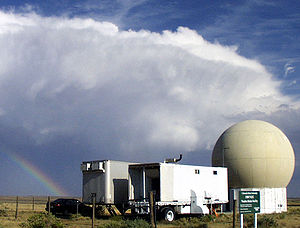CSU Pawnee S-band: Difference between revisions
(Created page with "==CSU-Pawnee== The CSU-Pawnee Doppler radar was a single-polarization S-band radar system, with a Klystron transmitter. It was decomissioned in March 2015. It was located 48 km NNW of the CSU-CHILL radar. The radar system was used in a dual-doppler configuration along with CSU-CHILL, and performed synchronized scans. center|300px|thumb|CSU-Pawnee Radar The radar transmitter frequency was 2.730 GHz, and used a vertically polarized antenna with...") |
(Added map) |
||
| Line 7: | Line 7: | ||
Some [[:Category:CHILL_PAW_dual_Doppler|example cases]] of dual-doppler data collected with the CHILL-Pawnee dual-doppler network are available on this website. | Some [[:Category:CHILL_PAW_dual_Doppler|example cases]] of dual-doppler data collected with the CHILL-Pawnee dual-doppler network are available on this website. | ||
{{#display_map:height=600|zoom=14|scrollwheelzoom=off| | |||
points=40.87115 N,104.714 W~CSU Pawnee Radar~[[Image:Pawnee Radar.jpg|center|300px|thumb|CSU-Pawnee Radar]] | |||
}} | |||
Revision as of 23:59, 3 February 2024
CSU-Pawnee
The CSU-Pawnee Doppler radar was a single-polarization S-band radar system, with a Klystron transmitter. It was decomissioned in March 2015. It was located 48 km NNW of the CSU-CHILL radar. The radar system was used in a dual-doppler configuration along with CSU-CHILL, and performed synchronized scans.

The radar transmitter frequency was 2.730 GHz, and used a vertically polarized antenna with a 1.6° beamwidth. The signal processor used was the same as that used in CHILL. The transmitter generated an output power of 425 kW. The radar was located at latitude 40° 52.269' (N 40.87115) and longitude 104° 42.84' (W 104.714) , at an altitude of 1688 m MSL.
Some example cases of dual-doppler data collected with the CHILL-Pawnee dual-doppler network are available on this website.